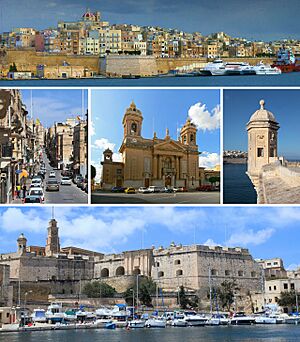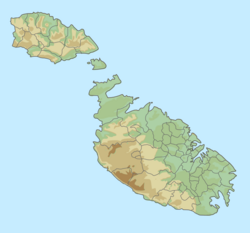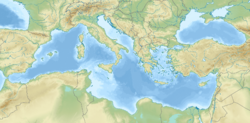Senglea facts for kids
Quick facts for kids
Senglea
L-Isla
Città Invicta, Civitas Invicta
|
|||
|---|---|---|---|
|
City and local council
|
|||

From top: Skyline, typical street, Parish Church, Gardjola, Land Front
|
|||
|
|||
| Motto(s):
Civitas Invicta (Belt Qatt Mirbuħa)
(Unconquered City) |
|||
| Country | |||
| Region | South Eastern Region | ||
| District | Southern Harbour District | ||
| Borders | Cospicua | ||
| Area | |||
| • Total | 0.2 km2 (0.08 sq mi) | ||
| Population | |||
| • Total | 2,720 | ||
| • Density | 14,000/km2 (35,000/sq mi) | ||
| Demonym(s) | Senglean (m), Sengleana (f), Sengleani (pl) Isolan (m), Isolana (f), Isolani (pl) |
||
| Time zone | UTC+1 (CET) | ||
| • Summer (DST) | UTC+2 (CEST) | ||
| Postal code |
ISL
|
||
| Dialing code | 356 | ||
| ISO 3166 code | MT-20 | ||
| Patron saint | Marija Bambina Christ the Redeemer |
||
| Day of festa | 8 September Third Sunday of June |
||
Senglea (in Maltese: L-Isla) is a fortified city in Malta. It is also known as Città Invicta, which means "Unconquered City." This special name was given because Senglea bravely fought off the Ottoman invasion during the Great Siege of Malta in 1565.
Senglea is one of the famous Three Cities located in the Grand Harbour area. The other two cities are Cospicua and Vittoriosa. About 2,720 people live in Senglea. The city got its name from Claude de la Sengle, a Grand Master who helped build it. Even though it's the 52nd most populated place in Malta, it's the second most crowded because it's very small. People in Senglea often speak a special local language called the Cottonera dialect.
Senglea was once part of a larger area called Birmula. When the Knights of St. John arrived in Malta, they decided to build three cities there. Senglea was the first, followed by Vittoriosa and Cospicua. The rest of the land was named Cottonera and was protected by strong walls.
Contents
History of Senglea
During the time of the Knights of St. John, Senglea was also used as a hunting ground. It was known as L'Isola di San Giuliano back then.
Early Buildings and City Status
In 1311, St. Julian's church was built in Isola. This was the first building in the area that later became Senglea. On May 8, 1552, work began on Fort St. Michael. This fort was designed by Pedro Pardo and finished in 1553. The walled city of Senglea was built over the next ten years. The area, once called Isola di San Giuliano, was given city status by Grand Master Claude De La Sengle and named after him.
The Great Siege and Plague
Senglea played a key role in the Great Siege of Malta in 1565. It was never conquered, earning it the title Civitas Invicta (Unconquered City) from Grand Master Jean Parisot de Valette. In 1581, Senglea became a Parish dedicated to the Nativity of Our Lady. A famous statue of Our Lady, known as "Il-Bambina," arrived around 1618. Sadly, a terrible plague in 1676 killed thousands of people in the city.
French Occupation and New Beginnings
In 1798, Senglea was part of the fight against French forces. The French were driven out of Malta in 1800. In 1813, Senglea narrowly avoided another plague. A statue of Our Lady was put up in the city center to show thanks.
The main church, the parish church, became a Basilica in 1921. This was decided by Pope Benedict XV. In the same year, Ignazio Panzavecchia, who was born in Senglea, was chosen as the first Prime Minister of Malta. However, because he was a priest, he decided not to take the job. So, Joseph Howard became Prime Minister instead.
World War II and Recovery
During World War II, Senglea was heavily bombed. Many buildings were destroyed, and many people died. On January 16, 1941, German planes attacked HMS Illustrious, a ship docked nearby. This attack killed 21 people and ruined most of Senglea's buildings, including the Basilica. King George VI visited the damaged city on June 20, 1943.
The rebuilt Basilica was officially opened by Archbishop Sir Mikiel Gonzi on August 24, 1957. The next day, the Basilica started its normal services again after almost 16 years. The statue of Marija Bambina was placed inside its new home with big celebrations.
Recent History and Achievements
Pope John Paul II visited Senglea in May 1990. To remember the 50th anniversary of the bombing, a monument was put up near the Basilica on September 5, 1991. This monument honors the local people who died in both World Wars. The first Local Council of Senglea was formed after an election on March 3, 1994. Stephen Perici was the first mayor.
In 2003, the Italian city of Cassino became a twin city with Senglea. In 2010, Senglea won a European Destinations of Excellence award for its water tourism.
Culture and Traditions
Senglea is well-known for its statue of Jesus Christ the Redeemer (Ir-Redentur tal-Isla). This statue is in the oratory of the basilica, which is dedicated to the birth of the Virgin Mary (Marija Bambina).
Senglea also has a statue of Mary, mother of Jesus, called Il-Madonna tan-Nofs. This means "Our Lady of the Centre." It was put in the city center during a plague. It was a way to give thanks because Senglea was the only town not affected by the illness.
The local band club is called "Socjeta' Filarmonika La Vincitrice." The city's football team, Senglea Athletic, was started in 1934.
Population and Demographics
Senglea is Malta's smallest area, covering just over half a square mile. It is also one of the most crowded places. Around the early 1900s, Senglea had over 8,200 people. This made it one of the most densely populated towns in Europe. At that time, Senglea and Cospicua were important centers for Malta's educated and wealthy people.
World War II changed Senglea's population a lot. Many people left to find safety in other towns and never came back. In recent years, the Cottonera Waterfront has been improved. It is now a yacht marina, which has attracted many people from other countries and business owners. In March 2014, Senglea's population was 2,784.
Getting Around Senglea
Senglea is connected to the capital city of Valletta by bus services. Before buses, people used boats to travel between the two cities. In July 2011, boat services started again. This happened because people complained that the new bus routes were too slow.
Famous People from Senglea
Many notable people have come from Senglea:
- Francesco Zahra (1710–1773), a painter who worked on many churches in Malta.
- Juan Bautista Azopardo (1772–1848), who started the Argentinian Navy in 1810.
- Giorgio Mitrovich (1795–1885), a politician who worked for more freedoms for Maltese people.
- Louis Shickluna (1808–1880), a shipbuilder whose shipyards in Canada built over 140 ships.
- Andrea De Bono (1821–1871), an explorer of the River Nile and the Sobat River in Africa.
- Ignazio Panzavecchia (1855–1925), a priest and politician who chose not to be Prime Minister in 1921.
- Mauro Inguanez (1887–1955), a priest and later a librarian in Valletta.
- John F. Marks (1894–1954), a politician who helped create Dar tal-Haddiema in Senglea. He worked for workers' rights and for Maltese and English languages in courts.
- Gigi Gauci (1911–2003), a politician and one of the people who started the Malta Labour Party.
- Charles Clews (1919–2009), a well-known actor and comedian.
- Anthony Perici (1920–2010), a politician and the first full-time Mayor of Twinsburg, Ohio.
- Charles Thake (1927–2018), an actor.
Twin Cities
Senglea is twinned with two other cities:
Images for kids
See also
 In Spanish: Senglea para niños
In Spanish: Senglea para niños




















